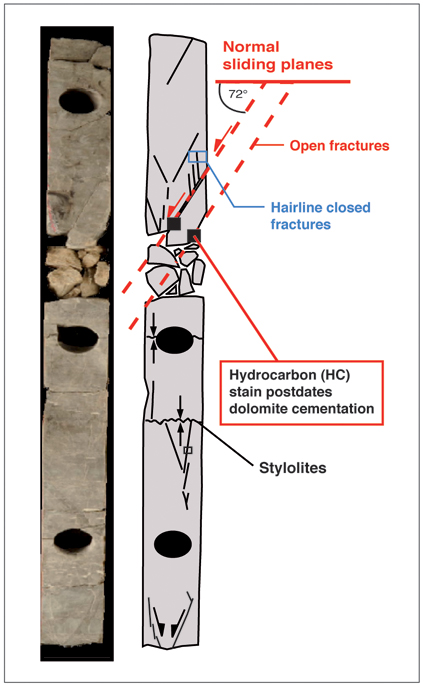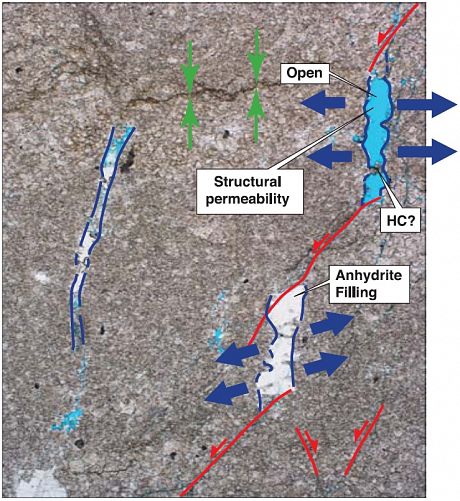Core Based Analysis
Core data has the highest geometrical resolution and allows investigation into the nature of the structural features intersected by the well, however, it is rarely oriented, and does not provide a reliable image of fracture aperture in subsurface conditions. While BHI data has a limited resolution (cm-scale at best) and only provides a ‘map’ (eg. resistivity) of the wellbore, it is always oriented, and offers some indication of fracture aperture in subsurface conditions. BHI data also give a real handle on the local orientation of the in situ stress, and usually covers a greater reservoir interval than the core.
The interpretation of structural data typically reveals:
Structural core logging
Fractures are logged over the whole cored interval by expert structural geologists. All data is recorded numerically and input directly into the Badley Ashton fracture log tool, which will automatically construct a graphical fracture density log.
A fracture classification scheme is devised prior to logging in agreement with the client. This scheme should emphasise the fracture properties which will impact on fluid circulation within the reservoir. The main distinction should be between filled/cemented fractures, which are likely to act as permeability barriers and compartmentalise the reservoir, and unfilled/uncemented fractures, which may, if they are open in the subsurface, act as thief zones, resulting in fluid channelling. Fractures should therefore be classified primarily on the basis of their aperture (open or closed).
Although a specific fracture classification scheme should be derived for each core analysed, a typical scheme is as follows:
A descriptive fracture table containing all fracture description data, represents the main record of structural core data, and constitutes the main deliverable.


Petrographic analysis of fracture fills
In cases where the structural analysis of the core shows a potential impact of cements and fracture fills on reservoir performance, a dedicated petrographic analysis of fracture fills (cements, clays, cataclasis) is recommended. Its aim will be to characterise the nature, structure, chronology and origin of the fracture fills, as well as to assess their potential impact on reservoir performance. Additional to the standard petrographic work on thin-sections, the fracture fill analysis should include the use of any relevant investigation technique such as cathodoluminescence, SEM, fluid inclusion analysis and XRD analysis.
Structural interpretation of BHI data
The picking of planar features is typically undertaken on BHI images at scales 1:10 to 1:50. Fractures are classified in terms of natural fractures, induced fractures and core breakouts. Qualifiers are added to this basic classification scheme in order to provide a description that is as accurate as possible. These qualifiers address the image character of the fracture (eg. resistive or conductive), its length (well spanning/partial), its geometry (planar, irregular), offset (fault) as well as the level of confidence of the interpretation. The tabulated fracture data table is then compiled, including all available fracture descriptors, (eg. depth, fracture type, dip and azimuth, length, connectivity, comments). The analysis and interpretation of the structural BHI data is then undertaken following a workflow similar to that of the analysis of structural core data.
Induced fractures and breakouts are in situ stress indicators and therefore will be used for the assessment of the orientation of the present day maximum horizontal stress around the well.
